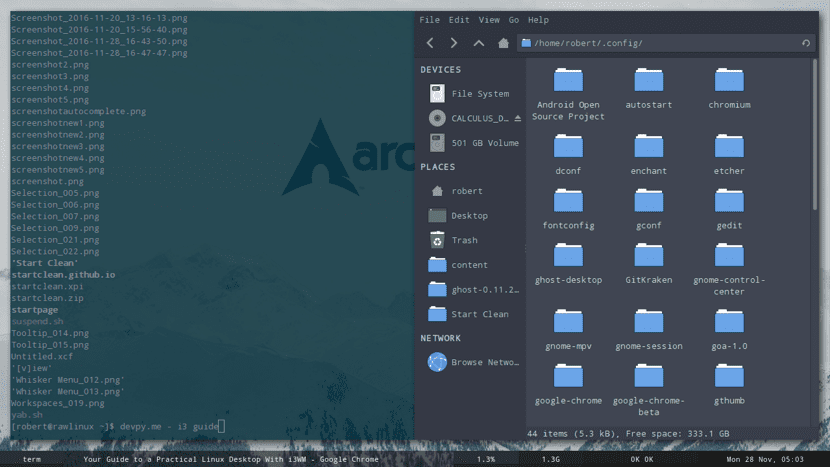
The new version of the i3wm 4.17 window manager has just been announced, version which support for transparency and some new elements have been added. For those who do not know about i3wm they should know that this is a window manager designed for X11, inspired by wmii and written in the C programming language.
The i3wm project It was created from scratch after a series of attempts to remove the defects of the wmii window manager. I3wm is distinguished by well-read and documented code, uses xcb instead of Xlib, correctly supports multi-monitor configurations, uses tree-shaped data structures for window positioning, provides an IPC interface, supports UTF-8, and maintains a minimal window design.
Supports overlapping and grouping windows, that handles dynamically. Configuration is handled via a plain text file, and i3 can be extended using its Unix Socket and JSON-based IPC interface with many programming languages.
I3 offers the advantages of using a tile window manager without the hassle of writing long and sometimes confusing scripts for setup. I3wm uses a plain text configuration file.
Like wmii, i3 uses a very similar control system to Vi. By default, the active window selection is controlled by the 'Mod1' (Alt Key / Super Key) and the keys of the middle row of the right hand (Mod1 + J, K, L ,;), while the movement of the Windows is handled by adding the Shift Key (Mod1 + Shift + J, K, L).
The project code is distributed under the BSD license.
What's new in i3wm version 4.17?
In this new version support for transparency was added for I3bar (the "–transparency" flag) and the ability to assign arbitrary border widths to it.
By default, the configuration guarantees the launch of xss-lock, nm-applet, pactl (volume control keys) and using the configuration file ~ / .config / i3 / config.
In ipc, there is a message queue involved and the retention of sending a restart command is ensured until the previous command completes.
As well fixed issues with i3bar when switching between desktops with a large number of windows as well as the implemented representation of the left and right edge of the header in stack mode.
For correct processing of emoji in the header area when using pixel fonts, a partial conversion from UTF-8 to UCS-2 is added.
Items for using the peek screen recorder have been added as well as an updated User Manual.
How to install i3wm on Linux?
For those who are interested in being able to install this window manager on their system, They can do so by following the instructions we share below.
For whoever they are Debian, Ubuntu users or any other derivative of these distributions, just open a terminal on your system and in it you just have to type the following command:
sudo apt install i3
While for the case of Arch Linux, Manjaro, Arco Linux or any other distro that is based on Arch Linux, They can install from a terminal by typing the following into it:
sudo pacman -Syy i3-wm i3status i3lock i3-gaps dmenu termite dunst
Now for those who are using Fedora or any other distribution based on this, they just have to type the following in a terminal:
sudo dnf install i3 i3status i3lock terminator sudo dnf install compton nitrogen udiskie sudo dnf install pasystray network-manager-applet pavucontrol sudo dnf install clipit
Finally for whoever openSUSE users in any of its desktop versions, they only have to type the following in a terminal:
sudo zypper install i3 dmenu i3status i3clock i3-gaps
And ready with it, they will have already installed this window manager on their Linux distribution. The next thing is to configure this manager, for this you can consult some tutorials on the net or on YouTube for it.